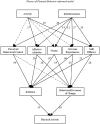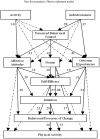Testing Theory of Planned Behavior and Neo-Socioanalytic Theory models of trait activity, industriousness, exercise social cognitions, exercise intentions, and physical activity in a representative U.S. sample
- PMID: 26300811
- PMCID: PMC4526790
- DOI: 10.3389/fpsyg.2015.01114
Testing Theory of Planned Behavior and Neo-Socioanalytic Theory models of trait activity, industriousness, exercise social cognitions, exercise intentions, and physical activity in a representative U.S. sample
Abstract
Prior research identified assorted relations between trait and social cognition models of personality and engagement in physical activity. Using a representative U.S. sample (N = 957), the goal of the present study was to test two alternative structural models of the relationships among the extraversion-related facet of activity, the conscientiousness-related facet of industriousness, social cognitions from the Theory of Planned Behavior (perceived behavioral control, affective attitudes, subjective norms, intentions), Social Cognitive Theory (self-efficacy, outcome expectancies), and the Transtheoretical Model (behavioral processes of change), and engagement in physical activity. Path analyses with bootstrapping procedures were used to model direct and indirect effects of trait and social cognition constructs on physical activity through two distinct frameworks - the Theory of Planned Behavior and Neo-Socioanalytic Theory. While both models showed good internal fit, comparative model information criteria showed the Theory-of-Planned-Behavior-informed model provided a better fit. In the model, social cognitions fully mediated the relationships from the activity facet and industriousness to intentions for and engagement in physical activity, such that the relationships were primarily maintained by positive affective evaluations, positive expected outcomes, and confidence in overcoming barriers related to physical activity engagement. The resultant model - termed the Disposition-Belief-Motivation model- is proposed as a useful framework for organizing and integrating personality trait facets and social cognitions from various theoretical perspectives to investigate the expression of health-related behaviors, such as physical activity. Moreover, the results are discussed in terms of extending the application of the Disposition-Belief-Motivation model to longitudinal and intervention designs for physical activity engagement.
Keywords: Neo-Socioanalytic Theory; Theory of Planned Behavior; industriousness; personality; physical activity; social cognition; trait activity.
Figures



Similar articles
-
Conscientiousness, the transtheoretical model of change, and exercise: a neo-socioanalytic integration of trait and social-cognitive frameworks in the prediction of behavior.J Pers. 2008 Jul;76(4):775-802. doi: 10.1111/j.1467-6494.2008.00504.x. Epub 2008 May 12. J Pers. 2008. PMID: 18482356
-
Predicting school students' physical activity intentions in leisure-time and school recess contexts: Testing an integrated model based on self-determination theory and theory of planned behavior.PLoS One. 2021 Mar 26;16(3):e0249019. doi: 10.1371/journal.pone.0249019. eCollection 2021. PLoS One. 2021. PMID: 33770119 Free PMC article.
-
Social cognition, personality and social-political correlates of health behaviors: Application of an integrated theoretical model.Soc Sci Med. 2024 Apr;347:116779. doi: 10.1016/j.socscimed.2024.116779. Epub 2024 Mar 17. Soc Sci Med. 2024. PMID: 38513564
-
Breaking barriers to rehabilitation: the role of behavior change theories in overcoming the challenge of exercise-related behavior change.Braz J Phys Ther. 2023 Nov-Dec;27(6):100574. doi: 10.1016/j.bjpt.2023.100574. Epub 2023 Nov 22. Braz J Phys Ther. 2023. PMID: 38056192 Free PMC article. Review.
-
Social cognition correlates of self-management behaviors in patients with familial hypercholesterolemia (FH): A meta-analytic review.Soc Sci Med. 2024 Jun;351:116968. doi: 10.1016/j.socscimed.2024.116968. Epub 2024 May 11. Soc Sci Med. 2024. PMID: 38759387 Review.
Cited by
-
Predicting Adolescents' Physical Activity Intentions: Testing an Integrated Social Cognition Model.Int J Behav Med. 2024 Feb;31(1):41-54. doi: 10.1007/s12529-023-10156-3. Epub 2023 Mar 22. Int J Behav Med. 2024. PMID: 36949326 Free PMC article.
-
Too soon to worry? Longitudinal examination of financial planning for retirement among Spanish aged workers.PLoS One. 2018 Dec 14;13(12):e0209434. doi: 10.1371/journal.pone.0209434. eCollection 2018. PLoS One. 2018. PMID: 30550605 Free PMC article.
-
A bitter pill to swallow? Impact of affective temperaments on treatment adherence: a systematic review and meta-analysis.Transl Psychiatry. 2022 Sep 2;12(1):360. doi: 10.1038/s41398-022-02129-z. Transl Psychiatry. 2022. PMID: 36056016 Free PMC article.
-
"Inconsistency between words and deeds": a meta-analysis of the moderating and mediating mechanisms of bridging the exercise-intentional-behavior gap.Front Psychol. 2025 May 21;16:1586176. doi: 10.3389/fpsyg.2025.1586176. eCollection 2025. Front Psychol. 2025. PMID: 40470022 Free PMC article.
-
Automated telephone communication systems for preventive healthcare and management of long-term conditions.Cochrane Database Syst Rev. 2016 Dec 14;12(12):CD009921. doi: 10.1002/14651858.CD009921.pub2. Cochrane Database Syst Rev. 2016. PMID: 27960229 Free PMC article.
References
-
- Ajzen I. (1991). The theory of planned behavior. Organ. Behav. Hum. Decis. Process 50 179–211. 10.1016/0749-5978(91)90020-T - DOI
-
- Ajzen I. (2002). Perceived behavioral control, self-efficacy, locus of control, and the theory of planned behavior. J. Appl. Soc. Psychol. 32 665–683. 10.1111/j.1559-1816.2002.tb00236.x - DOI
-
- Ajzen I. (2011). “Behavioral interventions: design and evaluation guided by the theory of planned behavior,” in Social Psychology and Evaluation eds Mark M. M., Donaldson S. I., Campbell B. (New York, NY US: Guilford Press; ) 72–101.
-
- Ajzen I., Madden T. J. (1986). Prediction of goal-directed behavior: attitude, intentions, and perceived behavioral control. J. Exp. Soc. Psychol. 22 453–474. 10.1016/0022-1031(86)90045-4 - DOI
-
- Akaike H. (1987). Factor analysis and AIC. Psychometrika 52 317–332. 10.1007/bf02294359 - DOI
LinkOut - more resources
Full Text Sources
Other Literature Sources

